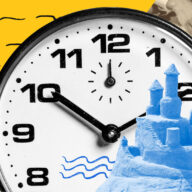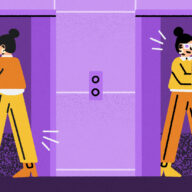Years of hard work, innovation, and unprecedented collaboration between teams in the U.K. and France make the impossible, possible: the first French Concorde prototype takes flight, and a new page in aviation history is written. But the supersonic airplane isn’t ready to ferry passengers just yet.
As you’ll hear in episode 3, Concorde’s journey from prototype to commercial air travel is beset by unforeseen challenges throughout the 1970s. The Oil Crisis makes the gas-guzzling plane commercially unviable, and several international carriers cancel their orders. Environmentalists protest against Concorde with claims of “Aviation Colonialism,” and some communities are dealing with “sonic booms” – the thunderous clap heard from the ground when a Concorde flying overhead breaks the speed of sound. Not everyone’s happy with the realities of the supersonic dream – and they make their displeasure known.
Subscribe wherever you get your podcasts:
Episode References
Books
“Concorde: A Designer’s Life”, Ted Talbot, The History Press, 2013
“Aerospatiale/BAC Concorde”, David Leney and David Macdonald, Hayne’s Icons, 2010
“Concorde: The Rise and Fall of the Supersonic Airliner”, Jonathan Glancey, Atlantic Books, 2015
“The Concorde Story”, seventh edition, Christopher Orlebar, Osprey, 2011
Videos
Concorde – A Supersonic Story (BBC Documentary) https://www.youtube.com/watch?v=1OIrV7ztsK0
Why testing Concorde took 7 years https://youtu.be/nh3ty6wp6qQ
What Actually Happened to the Concorde https://youtu.be/8Oi8ZO-2Kvc
Why You Never Got to Fly The American Concorde: The 2707 SST Story https://youtu.be/Y91Zr480Tn4
Why You Wouldn’t Want to Fly On The Soviet Concorde – The TU-144 Story https://youtu.be/VFWbuKr5-I8
Why You Couldn’t Afford To Fly Concorde https://youtu.be/sFBvPue70l8
Morley Safer’s 1974 report on the Concorde https://www.cbsnews.com/video/60-minutes-archive-morley-safers-1974-report-on-the-concorde
Articles
“Two Airlines Cancel Concorde Orders” New York Times, 1973 https://www.nytimes.com/1973/02/01/archives/2-airlines-cancel-concorde-orders-pan-american-and-twa-giving-up.html
“Concorde Scare” Washington Post, 1979
“US Brief Opposes Port Authority Ban” New York Times, 1977
“N.Y. Concorde Ban Voided” Washington Post, 1977
“Boom and Bust” Slate, 2014
https://slate.com/technology/2014/07/oklahoma-city-sonic-boom-tests-terrified-residents-in-1964.html
Websites
Mach 2 Magazine https://mach-2-magazine.co.uk/
Concorde SST https://www.concordesst.com/
Heritage Concorde https://www.heritageconcorde.com/
Episode Extras
Transcript
Nastaran Tavakoli-Far:
It’s March 2nd, 1969, and we’re in Toulouse. It’s a moment the French and the British teams have been dreaming about for years. Concorde is about to fly for the first time.
Pathe News Clips:
After six years of designing and building, delays and progress, the dream was a reality. Concorde nosed slowly out towards the starting point of her flying career. The all important final pre-flight check carried out by Chief Pilot Andre Turcat and his crew went without a hitch. This was it.
Nastaran Tavakoli-Far:
The French Concorde prototype races down the runway. It slowly begins to lift its nose. Within seconds, the plane is at the steep angle it needs for takeoff. Then the back tires lift off the ground. Two plumes of black smoke pour out of its engines as Concorde takes to the air.
Despite being millions of pounds over the estimated cost and with some serious question marks hanging over the project, Concorde flies. After completing the successful maiden flight, the world’s press asks pilot, Andre Turcat, for his thoughts.
Pathe News Clips:
The big bird flies, he said, it’s the beginning of the big work.
Nastaran Tavakoli-Far:
That is an understatement. It’s already been a hell of a lot of work getting the prototype into the air. But now the work begins on testing it and introducing it in person to the world. An introduction that’s supposed to guarantee Concorde’s future success.
But as we’ll hear in this episode, things don’t go to plan. The seventies will be a tumultuous decade for Concorde. It will come up against the oil crisis and environmentalism. It will be accused of aviation colonialism and elitism. And countries around the world will simply say no to Concorde. Putting its future in doubt.
You’re listening to Making an Impossible Airplane, the Untold Story of Concorde. I’m Nastaran Tavakoli-Far, and this is Teamistry. An original podcast from Atlassian, makers of collaborative software, including Jira, Trello, and Confluence.
One month after the French prototype’s successful maiden voyage, it was the turn of the Brits to test fly their own prototype. Nigel Ferris – a clerk at the Brabazon Hangars where it was being built – was there on ninth April, 1969. So he took us to the actual runway in Filton where it all happened.
Nigel Ferris:
So on that day, just about every single employee at BAC here at Filton came down to the side of the runway here to watch it happen. We all stood very close. And the colleague I was with suggested to me that we better move back because once you started up and moved, it was obviously parallel to the runway. But then as you turned out, the exhaust would be facing towards us. And he said we better move back because we’re going to get blown over. And I said, no, I’m going to stay here because I want to smell the kerosene. I want to feel the blast of the engines. And if I get blown over, that’d be something to talk about at dinner parties and things for the rest of my life.
Pathe News Clips:
The eyes of the world were on Concorde 002 as she taxied towards the runway at Filton. It was Chief Test Pilot Brian Trubshaw’s decision whether she flew or not. It could be another high speed taxi test. But the great bird looked ready to fly, and fly she did.
Pedro:
Did you get blown over?
Nigel Ferris:
No, I didn’t.
Nastaran Tavakoli-Far:
But for British Concorde 002’s first flight, there was still one major concern, getting back down to Earth. Aviation historian, Jonathan Glancey, picks up the story.
Jonathan Glancey:
When he came into land, his two radio altimeters indicating his height on approach failed, both of them. It’s very rare. And so Brian’s left with this brand new aircraft, the first time he’s taken it on the public test. Everyone’s watching, the cameras are out there, BBC, the whole lot. And he has to, as pilots call it, eyeball the landing.
When you fly an aircraft in towards an airport, of course you reduce the power and come in gently. But Concorde wouldn’t do that. Remember, it’s relying on these huge vortexes of air, which are keeping it up because of the brilliant wing design. But it still has to fly fast to achieve that. And so it came in fast.
And having been in the cockpit of Concorde, it’s very interesting, because it sits so high up, the ground’s a long way down. So what that means is that it’s very hard to judge by eye those last few feet. And you think, well, so what? A few feet? Yeah, but a few feet and a big machine like that, there’s a hell of a bang if you hit the ground. And what would happen is that the undercarriage could collapse, the thing could scrape along the ground. You might set off fire in a fuel tank and so on. So, that was a nail biting moment for Trubshaw. But of course he did it with aplomb.
Nastaran Tavakoli-Far:
Trubshaw later said about the rather hard landing, “we arrived about half a second early.”
Now after hearing the story about Concorde’s cockpit – or flight deck as it’s also known – I wanted to see one for myself.
So thanks to the lovely people at Aerospace Bristol Museum and Nigel Ferris, I got the chance of a lifetime and so did my producer, Pedro, who was honestly absolutely giddy.
Pedro:
Are the keys in the ignition? The keys are in the ignition, right?
Nastaran Tavakoli-Far:
So we’re just walking in. The ceiling’s quite low. I am thankfully short. So we’re going into the cockpit. It’s very … there’s all sorts of dials and switches. So I’m just seeing lighting, cockpit, door, throttle master. Yeah, just lots of stuff. It’s just really cool physically seeing it. Especially I guess because we’re in a very digital age. So just seeing all these kinds of analog dials and switches and levers and stuff.
Pedro:
It’s incredibly tight. It’s almost claustrophobic.
Nigel Ferris:
The thing is, the flight crew were only here for three and a half hours or so. So it’s not like a normal transatlantic flight. It was quite livable if I can say that. Three crew, a flight engineer here, captain on the left hand side, first officer, co-pilot on the right hand side.
Nastaran Tavakoli-Far:
So the flight engineer would sit here. I’d say the panel is about a meter and a half by a meter and a half or something like that. Just loads and loads of dials and stuff. So yeah, we have fuel management, temperature control, cabin pressure control.
Nigel Ferris:
The flight engineer had to monitor every single system. So this one in the center is basically the fuel control panel. You had to transfer fuel front to back and so on across the aircraft during the flight.
Nastaran Tavakoli-Far:
I’m going to stop Nigel here for a second, because this is something super, super important about Concorde that I want you to understand.
So I’m sitting there in the flight engineer’s chair, and in front of me is a panel of controls for 13 fuel tanks. Those tanks are distributed all over the bottom of the plane, a couple near the front, a bunch in the wings, and one at the very back. But you heard Nigel say something about transferring fuel, right? Okay. So listen to this, it’s just bonkers. But it’s a brilliant solution the engineers came up with to overcome a major problem.
You see, when an aircraft flies at supersonic speeds, the center of pressure, so where the body of the plane actually feels the aerodynamic pressure of the air, moves further back causing the plane to dip forward. So to balance it out, the flight engineer would actually pump fuel from the front of the plane to the back of the plane while in flight.
Then when they came out of supersonic speed, they’d move the fuel back to the front, what was left of it anyway. It’s out of the box thinking by engineers. Quite literally.
Okay, back to the flight deck and my attempt to get into the captain’s chair.
Cool. Awesome. So it’s so tight in here. I mean, I’m five foot two and I’m stooped over and stuff. It feels like being inside a fighter plane or something. I don’t know. It’s really tiny.
Nigel Ferris:
Yeah, well, I’m five foot 12″ and it’s difficult for me.
Nastaran Tavakoli-Far:
Yeah, you are sitting on the floor literally.
Nigel Ferris:
Yeah. Now on take off, very quickly, you’ve got the four thrust levers in the center here.
Nastaran Tavakoli-Far:
Can I push this?
Nigel Ferris:
Please.
Nastaran Tavakoli-Far:
I want to push this lever.
Nigel Ferris:
Push the throttles. Yeah. Three, two, one, now. That’s it. You rev the engines up and you’re starting your takeoff.
Nastaran Tavakoli-Far:
That feels great. So I mean, it’s interesting just how mechanical everything is. I mean, it’s just very physical. You can just kind of get a sense of how they could really feel and control.
Nigel Ferris:
Gosh, they loved flying it.
Nastaran Tavakoli-Far:
Can I take one or two quick photos?
Nigel Ferris:
Oh gosh. Do you want me to do it?
Pedro:
Yeah, yeah, yeah.
Nastaran Tavakoli-Far:
Can I have a photo of me sitting in that chair?
Nigel Ferris:
Yeah, come on.
Pedro:
Love it. Let me just turn this thing off…
Nastaran Tavakoli-Far:
You can hear me actually falling in love with Concorde, can’t you? And you can see those photos and many more in our show notes.
Now so far on this series, we’ve looked at the almost impossible challenges the engineers and designers faced when building Concorde. But at this point, we’re going to start looking at the bigger picture and the massive external challenges the plane faced as it tried to move from prototypes to passenger service.
And the first challenge is what happens when a supersonic jet initially goes past the speed of sound, the sonic boom.
Jonathan Glancey:
I think everybody is shocked when they first hear a supersonic boom because, boy, it’ll make you jump out of your skin. It’s really, really loud.
Nastaran Tavakoli-Far:
This is going to get a little bit technical, but stick with me. In simple terms, here’s how to understand sonic booms. When an object moves through the air, it pushes molecules out of the way in waves. As the object moves faster and faster, these waves get compressed.
Now, if the object is going fast enough, specifically the speed of sound, the waves can’t get out of the way in time and are crushed into one large shockwave. A supersonic jet creates two of these, one at the front of the plane where these waves are being compressed, and one at the back when the waves quickly snap back to normal.
Pedro:
Have you heard a sonic boom?
Yves Gourinat:
Of course. Of course. Not the Concorde one. But I live near an air force base and during the trainings we always had sonic booms.
Pedro:
How was it?
Yves Gourinat:
Very good. I liked it. I loved it. Yes. Ba boom, ba boom, yes, ba boom.
Nastaran Tavakoli-Far:
That’s Yves Gourinat. He’s an aviation professor at the University of Toulouse and worked at Airbus during the last decade of Concorde’s run. He was also witness to France’s iconic fighter, the Mirage.
Yves Gourinat:
And here with the Mirage aircraft, the two booms were very, very good. Yes.
Nastaran Tavakoli-Far:
Could you feel it in your body?
Yves Gourinat:
Yes, but we survived.
Nastaran Tavakoli-Far:
So Yves might enjoy the noise of a sonic boom. But back in the sixties when the phenomenon was relatively new, governments wanted to find out just how bothersome they were.
To pave the way for their own supersonic jet program, the US government planned in 1964 to submit the city of Oklahoma to sonic booms. They chose Oklahoma because so many of the city’s residents were employed in the aviation industry. The thinking was they’d be more amenable to sonic booms. But it wasn’t just a few booms: it was six months of daily sonic booms, eight times a day, starting at 7:00 AM.
The results were not what you’d expect actually. The vast majority of citizens said they could learn to live with the noise. Only 3% lodged formal complaints. But that was still 15,000 angry people. Many of those people filed claims for damages. Some were for cracked walls and broken glass, while others claimed that entire flocks of chickens produced fewer eggs.
The US Federal Aviation Administration dismissed almost all of these claims as lacking evidence or credibility, even the ones that were credible and had evidence. In fact, the bad blood created by the political fall out of the tests eventually led to supersonic flights being banned over the US.
France and Britain also conducted sonic boom tests in the 60s, but not to the extent of Oklahoma. Even so, there were complaints. Tones of them. Which eventually led to a supersonic flight ban over Europe. Concorde magazine editor Katie John.
Katie John:
There were complaints when the prototypes were first flown supersonically over land, which was why they realized they couldn’t do that because people’s windows were shattering in greenhouses and tomatoes were being stabbed with flying glass and things. But even so, that could be overstated.
Nastaran Tavakoli-Far:
The fear of the sonic boom was huge in the sixties. But not always based on evidence as Oklahoma proved. Here’s what Concorde chief design engineer, Ted Talbot, wrote in his memoir about the effect on local buildings in Britain.
Ted Talbot:
Take the stained glass window of a church near the test base for instance, the vicar and churchwardens expressed worries, which were deflected when it was demonstrated that the windows stood to have more damage inflicted by the bottom notes of the church organ.
Nastaran Tavakoli-Far:
Yves has a story as well about fear driving people to hear something that simply wasn’t there.
Yves Gourinat:
When they made the test about the boom, they made tests in the south of France, and they published in the newspapers the time when the aircraft would pass in order that the people could give their impression. Unfortunately, there was a technical problem this morning, the aircraft could not take off. But they received letters saying that some people heard, yes, yes, the flight did not occur.
Nastaran Tavakoli-Far:
But the idea that sonic booms were harmful or dangerous even had spread around the world. And it was into this world that the prototypes embarked. They were shown off on international tours to drum up sales and to shore up airline orders that had been placed in the sixties.
Katie John:
There was a series of sales flights by Britain and France. And I think it was a success in that people got to see Concorde for themselves for the first time. One Australian man said he’d actually gone to Sydney to protest about Concorde arriving. And he thought, dreadful, noisy, smokey monster. And he was going to stand there and shout at it when it came. And he said he saw the shape coming and he just fell in love with it. And his opinion just turned 180 degrees.
Nastaran Tavakoli-Far:
Sadly, for Concorde’s sales teams there were many people who didn’t have that Australians reaction.
Katie John:
In Japan, there was a lot of concern because the sales trip was made by the prototype Concorde, which had very, very noisy, smokey engines. That problem was subsequently solved to a great extent. But yeah, seeing 002 sitting on the runway belching out smoke worried the Japanese.
Nastaran Tavakoli-Far:
But people weren’t just worried about the sonic boom or the clouds of black smoke which gave the Concorde prototypes the nickname “Smokey Joe.” It was even the sound of Concorde taking off and landing.
News Clip:
The problem is this: noise. This is a 707. This is a 727. This is the Concorde noise. Loud, low frequency, a noise you can actually feel like a loud stereo set.
Nastaran Tavakoli-Far:
The idea of Concorde flying to the US was already in doubt in the early seventies.
News Clip:
We have to live here. Not the people that are building the jet, not the people that are pushing the jet to be a success. They don’t have to live here. We do, we got enough noise here.
Nastaran Tavakoli-Far:
One by one countries around the world started to voice serious concerns about this loud, smoky airplane. Mostly focused on the sonic boom. Katie John.
Katie John:
When they were doing test flights down the seaboard of India for example, and the sonic booms were landing, and the Indian government protested. And one of the things that they said to the British government was, why are you doing this to Indians when you won’t do it to British people? Are we less important than British people?
Nastaran Tavakoli-Far:
In 1975, the former British colony of Kenya was suggested as a testing ground for Concorde. This is Dr. Perez Olindo, then Kenya’s Director of National Parks being interviewed for British TV.
Perez Olindo:
There are a lot of reasons why any right thinking person should condemn the Concorde in the present world.
Reporter:
It’s quite a compliment for Kenya to have been selected as the area for these tests showing that Kenya has reached a considerable degree of technical sophistication, wouldn’t you agree with those people?
Perez Olindo:
If I was going to be hanged and someone complimented me for being chosen, I would not agree with him.
Nastaran Tavakoli-Far:
As Katie John points out, Concorde was seen by some as a form of aviation colonialism. That Concorde was not a dream of a wonderful new future, but a symbol of an elitist past.
Katie John:
I don’t know if you remember when the moon landings happened, and Gil Scott-Heron did that song ‘Whiteys on the Moon,’ you know: “people are starving all around the world, but whiteys on the moon.” Well, this must have seemed like an aviation version of that to some people.
Nastaran Tavakoli-Far:
We asked the Concorde engineers and designers we spoke with whether or not this political and financial turmoil worried their teams? John Britton.
John Britton:
We worried about them because obviously after Boeing stopped their SST, the movement in the States got quite strong against Concorde ever flying into the States. Because I mean this site here at Filton at one point was a hundred percent Concorde. So everybody working on the site, whether it was in manufacturing, design or whatever, we were all working on Concorde. So if Concorde had been canceled, you would’ve had hundreds, thousands of people here at Filton potentially being made redundant.
Nastaran Tavakoli-Far:
And those thousands of people had reason to worry. As the seventies dawned, countries around the world banned supersonic flight over land, crippling Concorde’s potential flight paths. Trips across Europe or the US were out of the question. And Concorde couldn’t hold enough fuel to cross the Pacific. That only left transatlantic flights. Would that generate enough income to support an entire fleet of planes?
Meanwhile, the teams of engineers back in Britain and France were hard at work perfecting the prototypes and preparing to build a fleet for commercial operation.
As we explained in past episodes, the rear fuselage was the responsibility of the British.
Yet the French were looking after the aerodynamics of the entire plane, and after some testing, Dudley Collard realized they could reduce air resistance by extending the tail well past the fin.
But the Brits, who were already building the rear of future Concorde aircraft, didn’t like that idea. So Dudley headed to the UK, to the Weybridge site, to plead his case.
Dudley Collard:
They had rear fuselages coming along on the production line. And here comes this muggins saying we can get a huge improvement if we lengthen it. I had to go up and defend it and tell them what I thought. And they wanted to do differently. And I said “no.” And I said no, because this is the one we’ve designed. We’ve done the testing and so on. Yours is slightly different. “Oh yes, but yours will weigh a bit heavier.” I said, “and yours will probably have higher drag.” And you think on the Concorde, if the drag went up 1%, you lose, well, about the equivalent of about five or six passengers.
Nastaran Tavakoli-Far:
In other words, if they overcame this wind resistance, they’d be able to accommodate more paying customers on the plane. It was a case of aerodynamics versus production with economics caught in the middle.
The Brits had already started preparing pieces for future Concorde aircraft and didn’t want to scrap all that work. But the French knew this would improve the plane. After Dudley made his case in person, the Brits gave in. As often happened during the production of Concorde, the right idea won.
This was an example of each side being willing to admit when they were wrong or if the other side had simply come up with a better plan. John Britton is clear that on their own each side could not have accomplished what they did together.
John Britton:
I mean, it took us 10 years to get from prototype to production. We couldn’t have done it in the timescale. And the facilities that were available. We had several factories here working on it, Filton, Weybridge, Rolls Royce, Snecma, Aerospatiale, Dassault, Hispano-Suiza, Messier, Landing Gear, you drew in the expertise from the different companies.
Nastaran Tavakoli-Far:
But this collaboration wasn’t just about combining the best of these different groups. It also allowed for any deficiencies on one team to be compensated by the other. And while it’s a great example of teamwork, sometimes there are challenges even great teamwork can’t overcome. Katie John explains.
Katie John:
The oil crisis jacked up the price of oil four fold. And then suddenly the economics of operating something as thirsty as Concorde looked a lot more shaky. And a lot of the airlines who’d put down options on Concorde backed out. They thought we can’t afford this because running any airliner was going to be massively more expensive. And Concorde, it was an unknown quantity. They didn’t know what they were letting themselves in for.
And then at the same time, the Boeing 747 had come into service. And it was a mass transport. And people doing their sums in the airlines suddenly realized we can make money on this where we probably may not be able to with supersonic aircraft.
Nastaran Tavakoli-Far:
In June of 1972, Air Canada was the first airline to cancel their options on Concorde. The hammer blow came early the following year when Pan Am, United and TWA canceled their options in quick succession. Pan Am felt Concorde just didn’t measure up to jumbo jets when it came to carrying loads of people for not much money. In fact, they correctly foresaw that operating Concorde would require much higher fares than originally assumed. Plus, they saw the future of air travel not as a race for speed, but a race to the bottom price wise.
By the end of 1973, almost all other airlines had pulled out. Despite that huge setback, in 1974 the governments of France and Britain approved the building of 16 Concorde aircraft. They’d already spent so much time and money, they might as well go for broke. Plus, who knows, maybe those airlines would change their minds.
And so back at the Brabazon Hangars and in Toulouse, most of the Concorde aircraft being assembled were white tails. John explains.
John Britton:
The first thing you do when you’re building an aircraft is you paint the tail with the color of the customer. So that anybody walking through the production line can see, that’s a British Airways, or that’s a Lufthansa aircraft, or that’s an Emirates aircraft. And they can see whether they’re working on the right aircraft or not.
And if you don’t have a customer for a particular aircraft, they’re called white tails. So the aircraft can be fully finished and rolled out off the production line. And if it’s a white tail, everybody knows that it’s not sold.
Nastaran Tavakoli-Far:
What does that do for the morale of a team?
John Britton:
Well, people are not happy about it obviously. But I think probably the people that were most upset about it was the taxpayers, because the British and the French taxpayers were financing all this.
Nastaran Tavakoli-Far:
Let’s call that a bit of dark humor. It’s how us Brits deal with difficult issues, to have a bit of a laugh.
But politicians and executives at British Aircraft Corporation and Sud Aviation, now known as Aerospatiale, weren’t laughing. The world had changed as Katie John tells us. And it didn’t bode well for Concorde.
Katie John:
I think the dreams of the 1950s and the 1970s were very different because they were very different worlds. In the 1950s, western Europe and North America had just come out of the Second World War and to kind of boost everybody up as much as anything else, they were looking to the future, looking to these fantastic new technical projects in aviation, industry, energy supply, all sorts of things. Everything was going to be bigger, better, faster.
And by the 1970s, things had changed so much. I mean, there’d been the Vietnam War, which was a difficult, unpleasant, traumatic war for everybody. And thousands of young men and billions of dollars were being lost. And people were also becoming more aware of the environmental costs of all our modern conveniences, not just aviation.
Nastaran Tavakoli-Far:
By the mid seventies, calls were growing from politicians, environmental groups and others to cancel the Concorde Project. But with so much time and money having been invested, abandoning it now seemed impossible.
Back at the Concorde production sites in Britain and France, of the airplanes being constructed, about half were not white tails. The only airlines that kept their orders were Air France, who purchased four, and British Airways who purchased five. And they only agreed to take on the planes because of political pressure. As nationalized businesses they had to help the government save face. But it was kind of a shell game, like the government buying planes from themselves.
For now, in 1976, just as all the political and economic pressure was building, and after nearly a decade and a half of development, British Airways and Air France were preparing to finally launch supersonic flights with paying passengers.
It’s the morning of 21st January, 1976, Concorde aircraft are lined up for takeoff at Heathrow Airport in London and Orly Airport outside of Paris. The plan is for them to depart at the exact same time, a tribute to the cooperation and collaboration that has led to this moment.
Thousands of people are gathered at the airports to witness this historic event. While on TV, an estimated 250 million people watch from around the world. At precisely the same moment, 12:40 local time in Paris, both supersonic jets begin to roll down the runway.
Both planes lift off in unison. The London flight headed to Bahrain in the Persian Gulf. And the Paris flight to Rio de Janeiro with a stopover in Senegal.
Despite the turmoil over Concorde’s future, the flights capture the world’s imagination. Jonathan Glancey and Katie John.
Jonathan Glancey:
I think what was exciting was the idea, apart from the sheer beauty of these aircraft, it was the fact that so much had been loaded against them. That Concorde wasn’t going to be able to do this. And you are willing it on, willing it on. And then yay, does it. And I think that was that excitement.
Katie John:
It was such an achievement. Even the Americans said that it paralleled their achievement in sending men to the moon. It was our moonshot in a way. And it was also the ultimate advertisement for British and French technical excellence. And it amazed everybody that people just wearing their ordinary clothes, shirt sleeves, business suits, dresses, could get on an aircraft that was traveling faster than a rifle bullet. And travel in complete safety and have a nice meal and look out the window and see the curvature of the earth and all these things.
Nastaran Tavakoli-Far:
But in episode one, when we contrasted the futuristic dream of Concorde with the almost 19th century reality of life in Europe, well, in the late seventies, once again, Concorde seemed out of step. And not just economically and environmentally.
While these folks were flying on Concorde in tailored suits and fine dresses, the Sex Pistols were playing their first shows in London. As 1976 continued, both the Air France and British Airways Concorde aircraft were far from full. Both airlines realized there was a key destination they needed in order to survive, New York City. The problem is New York didn’t want them.
Ricky Bastin:
There was a big movement in New York trying to say Concorde can’t go there because she’s going to make too much noise. The takeoff noise was very, very loud indeed. There’s no point in pretending otherwise.
Nastaran Tavakoli-Far:
This is Ricky Bastin. He started working on Concorde in 1974, and we’ll hear a lot more from him in the rest of the series.
Ricky Bastin:
It all hinged on New York because unless the airplane could get to New York, she was always going to lose money.
Nastaran Tavakoli-Far:
Despite completing an FAA audit that had cleared the way for Concorde to land in the United States, New York City protested. In March of 1976, just a few months after Concorde began commercial service, the Port Authority of New York banned Concorde because of noise concerns. Concorde’s only chance of survival was hanging in the balance. In fact, the battle for Concorde’s future would go all the way to the US Supreme Court.
Next time on Making an Impossible Airplane, the Untold Story of Concorde. The program faces a whole new raft of problems…
Mike Hall:
One of the things on this aircraft in particular that began to be a problem were the fact of her age.
Ricky Bastin:
It was a headache. There’s no point pretending otherwise, but you had to just roll your sleeves up, scratch your head and find out what’s wrong and go onto it.
Nastaran Tavakoli-Far:
But Concorde also becomes the sexiest airliner in the world.
Ricky Bastin:
Saw Michael Jackson quite a few times coming on and off. I flew back with Diana Ross. My first ever transatlantic was with David Bowie, one of my heroes.
Katie John:
There were ordinary people who’d saved up for years to get a flight on Concorde. One person even sold his house so that he could get a trip on Concorde.
Nastaran Tavakoli-Far:
That’s next time on Teamistry, an original podcast from Atlassian.









































